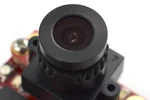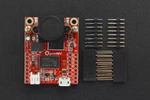








OpenMV Cam H7 Plus
Introduction
Note: OpenMV Cam H7 Plus will be restocked by June 2024.
The OpenMV Cam is a small, low power, microcontroller board which allows you to easily implement applications using machine vision in the real-world. You program the OpenMV Cam in high level Python scripts(courtesy of the MicroPython Operating System) instead of C/C++. This makes it easier to deal with the complex outputs of machine vision algorithms and working with high level data structures. But, you still have total control over your OpenMV Cam and its I/O pins in Python. You can easily trigger taking pictures and video on external events or execute machine vision algorithms to figure out how to control your I/O pins.
Interface Library:
The OpenMV Cam comes built-in with an RPC (Remote Python/Procedure Call) library which makes it easy to connect the OpenMV Cam to your computer, a SBC (single board computer) like the RaspberryPi or Beaglebone, or a microcontroller like the Arduino or ESP8266/32. The RPC Interface Library works over:
Features
Applications
TensorFlow Lite support lets you run custom image classification and segmentation models on board your OpenMV Cam. With TensorFlow Lite support you can easily classify complex regions of interest in view and control I/O pins based on what you see.
You can use Frame Differencing on your OpenMV Cam to detect motion in a scene by looking at what's changed. Frame Differencing allows you to use your OpenMV Cam for security applications.
You can use your OpenMV Cam to detect up to 16 colors at a time in an image (realistically you'd never want to find more than 4) and each color can have any number of distinct blobs. Your OpenMV Cam will then tell you the position, size, centroid, and orientation of each blob. Using color tracking your OpenMV Cam can be programmed to do things like tracking the sun, line following, target tracking, and much, much, more.
You can use your OpenMV Cam to detect groups of colors instead of independent colors. This allows you to create color makers (2 or more color tags) which can be put on objects allowing your OpenMV Cam to understand what the tagged objects are.
You can detect Faces with your OpenMV Cam (or any generic object). Your OpenMV Cam can process Haar Cascades to do generic object detection and comes with a built-in Frontal Face Cascade and Eye Haar Cascade to detect faces and eyes.
You can use Eye Tracking with your OpenMV Cam to detect someone's gaze. You can then, for example, use that to control a robot. Eye Tracking detects where the pupil is looking versus detecting if there's an eye in the image.
You can detect if there's a person in the field of view using our built-in person detector TensorFlow Lite model.
You can use Optical Flow to detect translation of what your OpenMV Cam is looking at. For example, you can use Optical Flow on a quad-copter to determine how stable it is in the air.
You can use the OpenMV Cam to read QR Codes in it's field of view. With QR Code Detection/Decoding you can make smart robots which can read labels in the environment.
The OpenMV Cam H7 can also detect and decode data matrix 2D barcodes too.
The OpenMV Cam H7 can also decode 1D linear bar codes. In particular, it can decode EAN2, EAN5, EAN8, UPCE, ISBN10, UPCA, EAN13, ISBN13, I25, DATABAR, DARABAR_EXP, CODABAR, CODE39, CODE93, and CODE128 barcodes.
Even better than QR Codes above, the OpenMV Cam H7 can also track AprilTags at 160x120 at up to about 12 FPS. AprilTags are rotation, scale, shear, and lighting invariant state-of-the-art fidicual markers.
Infinite line detection can be done speedily on your OpenMV Cam at near max FPS. And, you can also find non-infinite length line segments too.
You can use the OpenMV Cam H7 to easily detect circles in the image.
The OpenMV Cam H7 can also detect rectangles using our AprilTag library's quad detector code.
You can use template matching with your OpenMV Cam to detect when a translated pre-saved image is in view. For example, template matching can be used to find fiducials on a PCB or read known digits on a display.
You can use the OpenMV Cam to capture up to 640x480 Grayscale/RGB565 BMP/JPG/PPM/PGM images. You directly control how images are captured in your Python script. Best of all, you can preform machine vision functions and/or draw on frames before saving them.
You can use the OpenMV Cam to record up to 640x480 Grayscale/RGB565 MJPEG video or GIF images (or RAW video). You directly control how each frame of video is recorded in your Python script and have total control on how video recording starts and finishes. And, like capturing images, you can preform machine vision functions and/or draw on video frames before saving them.
Specification
Idle - μSD Card 140mA @ 3.3V
Active - No μSD Card 230mA @ 3.3V
Active - μSD Card 240mA @ 3.3V
Storage -40°C to 125°C
Operating -20°C to 70°C





